Data Governance and Management: An IT Report - University
VerifiedAdded on 2022/10/14
|7
|1470
|355
Report
AI Summary
This report delves into the multifaceted domain of data governance and data management, providing a comprehensive analysis of key concepts and contemporary challenges within the IT industry. The report begins by defining and explaining crucial terminologies such as Competitive Advantage, Data Discovery, Data Marts, Text Analytics & Mining, Business Continuity, and Electronic Records Management, establishing a foundational understanding of the subject matter. It then progresses to address the pressing sustainability issues confronting the IT sector, highlighting the environmental impact of electronic waste and the challenges posed by the increasing popularity of portable computers. Furthermore, the report investigates the ever-evolving landscape of cyber-threats, categorizing their intents and outlining various attack tactics, while also presenting effective defense mechanisms for businesses and individuals. It explores the intricacies of Advanced Persistent Threats (APT) and elucidates how the Defence-In-Depth Model can be strategically employed to mitigate cyber risks, offering a holistic perspective on data governance and management in the modern IT environment.
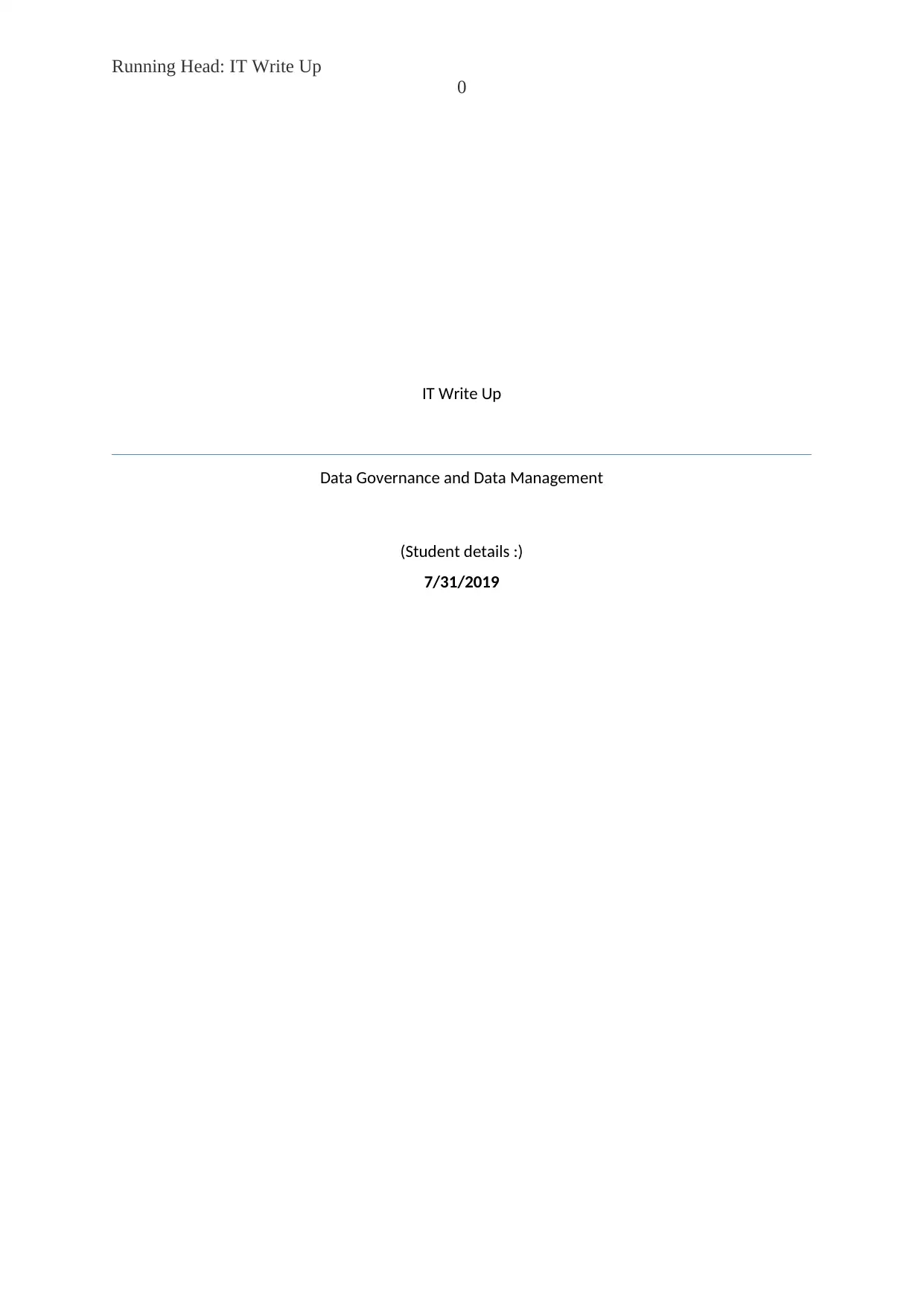
Running Head: IT Write Up
0
IT Write Up
Data Governance and Data Management
(Student details :)
7/31/2019
0
IT Write Up
Data Governance and Data Management
(Student details :)
7/31/2019
Paraphrase This Document
Need a fresh take? Get an instant paraphrase of this document with our AI Paraphraser
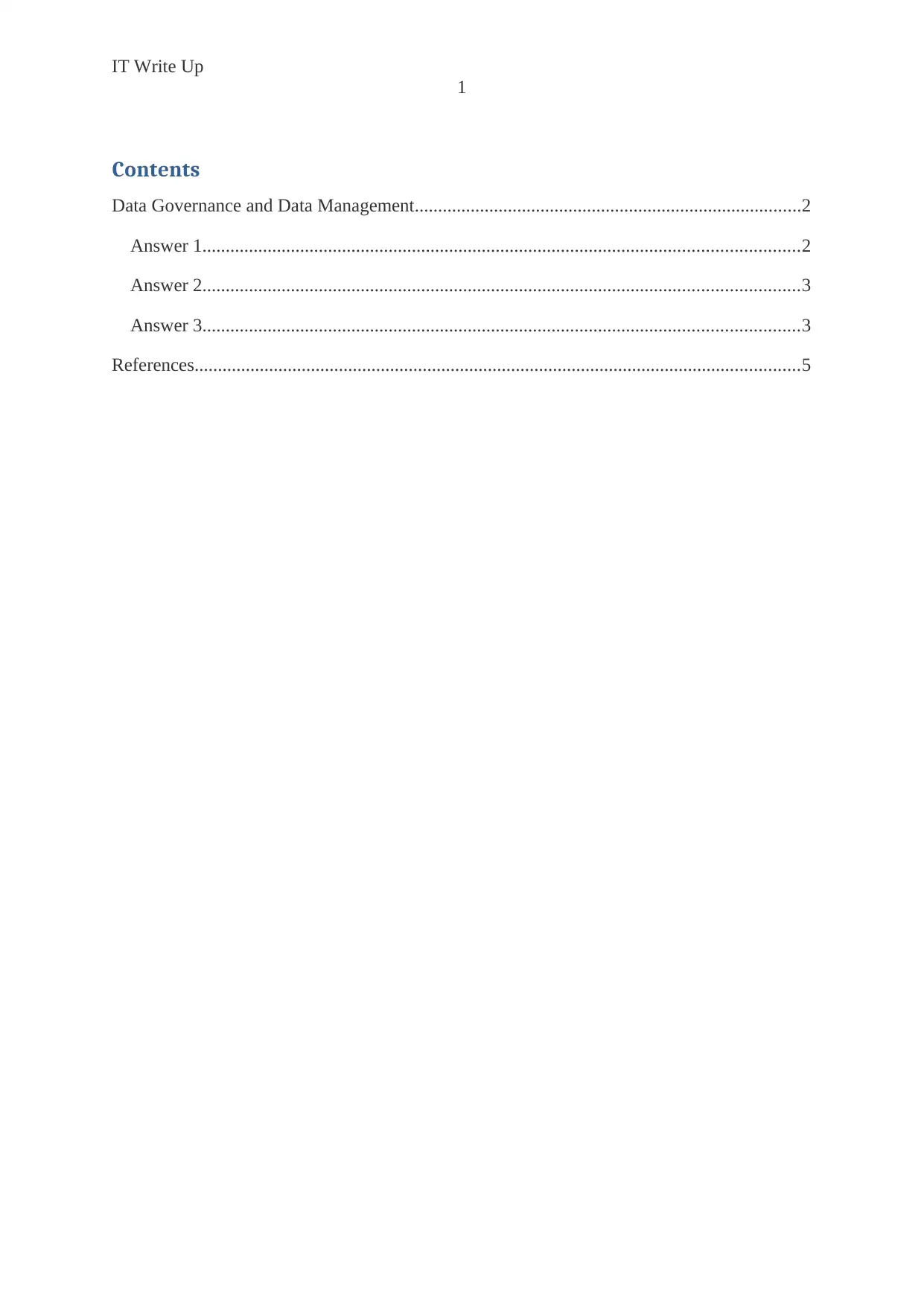
IT Write Up
1
Contents
Data Governance and Data Management...................................................................................2
Answer 1................................................................................................................................2
Answer 2................................................................................................................................3
Answer 3................................................................................................................................3
References..................................................................................................................................5
1
Contents
Data Governance and Data Management...................................................................................2
Answer 1................................................................................................................................2
Answer 2................................................................................................................................3
Answer 3................................................................................................................................3
References..................................................................................................................................5
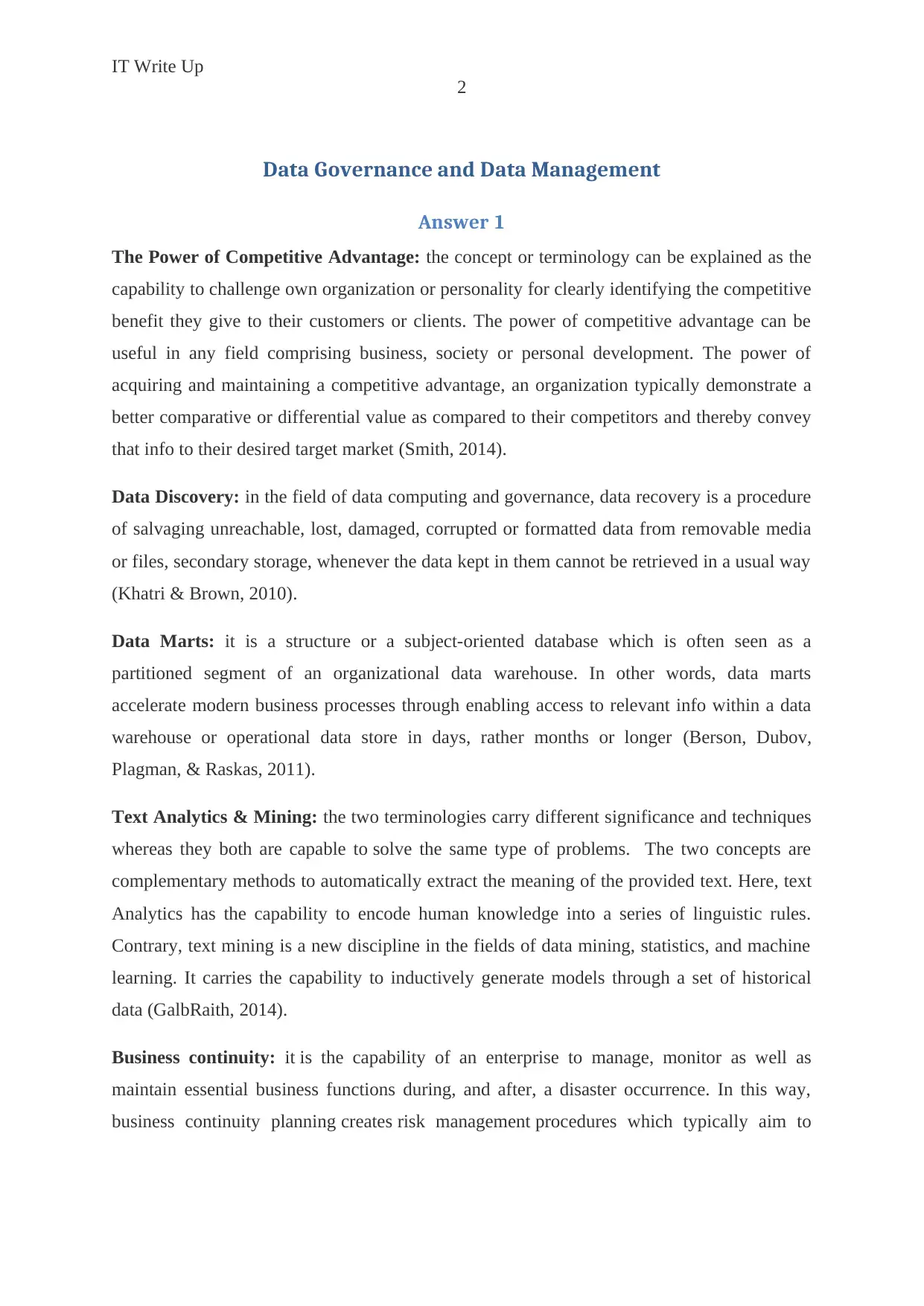
IT Write Up
2
Data Governance and Data Management
Answer 1
The Power of Competitive Advantage: the concept or terminology can be explained as the
capability to challenge own organization or personality for clearly identifying the competitive
benefit they give to their customers or clients. The power of competitive advantage can be
useful in any field comprising business, society or personal development. The power of
acquiring and maintaining a competitive advantage, an organization typically demonstrate a
better comparative or differential value as compared to their competitors and thereby convey
that info to their desired target market (Smith, 2014).
Data Discovery: in the field of data computing and governance, data recovery is a procedure
of salvaging unreachable, lost, damaged, corrupted or formatted data from removable media
or files, secondary storage, whenever the data kept in them cannot be retrieved in a usual way
(Khatri & Brown, 2010).
Data Marts: it is a structure or a subject-oriented database which is often seen as a
partitioned segment of an organizational data warehouse. In other words, data marts
accelerate modern business processes through enabling access to relevant info within a data
warehouse or operational data store in days, rather months or longer (Berson, Dubov,
Plagman, & Raskas, 2011).
Text Analytics & Mining: the two terminologies carry different significance and techniques
whereas they both are capable to solve the same type of problems. The two concepts are
complementary methods to automatically extract the meaning of the provided text. Here, text
Analytics has the capability to encode human knowledge into a series of linguistic rules.
Contrary, text mining is a new discipline in the fields of data mining, statistics, and machine
learning. It carries the capability to inductively generate models through a set of historical
data (GalbRaith, 2014).
Business continuity: it is the capability of an enterprise to manage, monitor as well as
maintain essential business functions during, and after, a disaster occurrence. In this way,
business continuity planning creates risk management procedures which typically aim to
2
Data Governance and Data Management
Answer 1
The Power of Competitive Advantage: the concept or terminology can be explained as the
capability to challenge own organization or personality for clearly identifying the competitive
benefit they give to their customers or clients. The power of competitive advantage can be
useful in any field comprising business, society or personal development. The power of
acquiring and maintaining a competitive advantage, an organization typically demonstrate a
better comparative or differential value as compared to their competitors and thereby convey
that info to their desired target market (Smith, 2014).
Data Discovery: in the field of data computing and governance, data recovery is a procedure
of salvaging unreachable, lost, damaged, corrupted or formatted data from removable media
or files, secondary storage, whenever the data kept in them cannot be retrieved in a usual way
(Khatri & Brown, 2010).
Data Marts: it is a structure or a subject-oriented database which is often seen as a
partitioned segment of an organizational data warehouse. In other words, data marts
accelerate modern business processes through enabling access to relevant info within a data
warehouse or operational data store in days, rather months or longer (Berson, Dubov,
Plagman, & Raskas, 2011).
Text Analytics & Mining: the two terminologies carry different significance and techniques
whereas they both are capable to solve the same type of problems. The two concepts are
complementary methods to automatically extract the meaning of the provided text. Here, text
Analytics has the capability to encode human knowledge into a series of linguistic rules.
Contrary, text mining is a new discipline in the fields of data mining, statistics, and machine
learning. It carries the capability to inductively generate models through a set of historical
data (GalbRaith, 2014).
Business continuity: it is the capability of an enterprise to manage, monitor as well as
maintain essential business functions during, and after, a disaster occurrence. In this way,
business continuity planning creates risk management procedures which typically aim to
⊘ This is a preview!⊘
Do you want full access?
Subscribe today to unlock all pages.

Trusted by 1+ million students worldwide
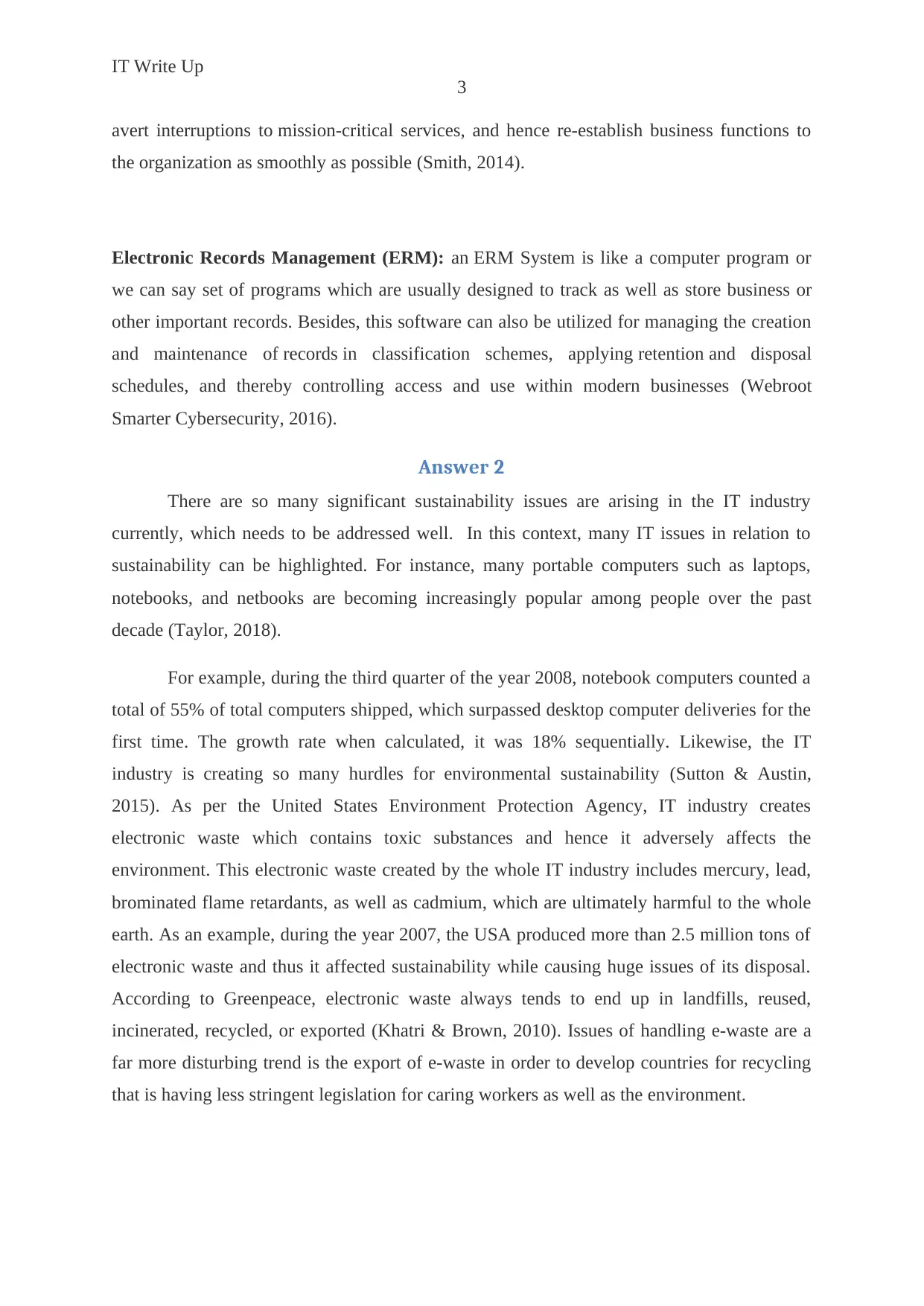
IT Write Up
3
avert interruptions to mission-critical services, and hence re-establish business functions to
the organization as smoothly as possible (Smith, 2014).
Electronic Records Management (ERM): an ERM System is like a computer program or
we can say set of programs which are usually designed to track as well as store business or
other important records. Besides, this software can also be utilized for managing the creation
and maintenance of records in classification schemes, applying retention and disposal
schedules, and thereby controlling access and use within modern businesses (Webroot
Smarter Cybersecurity, 2016).
Answer 2
There are so many significant sustainability issues are arising in the IT industry
currently, which needs to be addressed well. In this context, many IT issues in relation to
sustainability can be highlighted. For instance, many portable computers such as laptops,
notebooks, and netbooks are becoming increasingly popular among people over the past
decade (Taylor, 2018).
For example, during the third quarter of the year 2008, notebook computers counted a
total of 55% of total computers shipped, which surpassed desktop computer deliveries for the
first time. The growth rate when calculated, it was 18% sequentially. Likewise, the IT
industry is creating so many hurdles for environmental sustainability (Sutton & Austin,
2015). As per the United States Environment Protection Agency, IT industry creates
electronic waste which contains toxic substances and hence it adversely affects the
environment. This electronic waste created by the whole IT industry includes mercury, lead,
brominated flame retardants, as well as cadmium, which are ultimately harmful to the whole
earth. As an example, during the year 2007, the USA produced more than 2.5 million tons of
electronic waste and thus it affected sustainability while causing huge issues of its disposal.
According to Greenpeace, electronic waste always tends to end up in landfills, reused,
incinerated, recycled, or exported (Khatri & Brown, 2010). Issues of handling e-waste are a
far more disturbing trend is the export of e-waste in order to develop countries for recycling
that is having less stringent legislation for caring workers as well as the environment.
3
avert interruptions to mission-critical services, and hence re-establish business functions to
the organization as smoothly as possible (Smith, 2014).
Electronic Records Management (ERM): an ERM System is like a computer program or
we can say set of programs which are usually designed to track as well as store business or
other important records. Besides, this software can also be utilized for managing the creation
and maintenance of records in classification schemes, applying retention and disposal
schedules, and thereby controlling access and use within modern businesses (Webroot
Smarter Cybersecurity, 2016).
Answer 2
There are so many significant sustainability issues are arising in the IT industry
currently, which needs to be addressed well. In this context, many IT issues in relation to
sustainability can be highlighted. For instance, many portable computers such as laptops,
notebooks, and netbooks are becoming increasingly popular among people over the past
decade (Taylor, 2018).
For example, during the third quarter of the year 2008, notebook computers counted a
total of 55% of total computers shipped, which surpassed desktop computer deliveries for the
first time. The growth rate when calculated, it was 18% sequentially. Likewise, the IT
industry is creating so many hurdles for environmental sustainability (Sutton & Austin,
2015). As per the United States Environment Protection Agency, IT industry creates
electronic waste which contains toxic substances and hence it adversely affects the
environment. This electronic waste created by the whole IT industry includes mercury, lead,
brominated flame retardants, as well as cadmium, which are ultimately harmful to the whole
earth. As an example, during the year 2007, the USA produced more than 2.5 million tons of
electronic waste and thus it affected sustainability while causing huge issues of its disposal.
According to Greenpeace, electronic waste always tends to end up in landfills, reused,
incinerated, recycled, or exported (Khatri & Brown, 2010). Issues of handling e-waste are a
far more disturbing trend is the export of e-waste in order to develop countries for recycling
that is having less stringent legislation for caring workers as well as the environment.
Paraphrase This Document
Need a fresh take? Get an instant paraphrase of this document with our AI Paraphraser
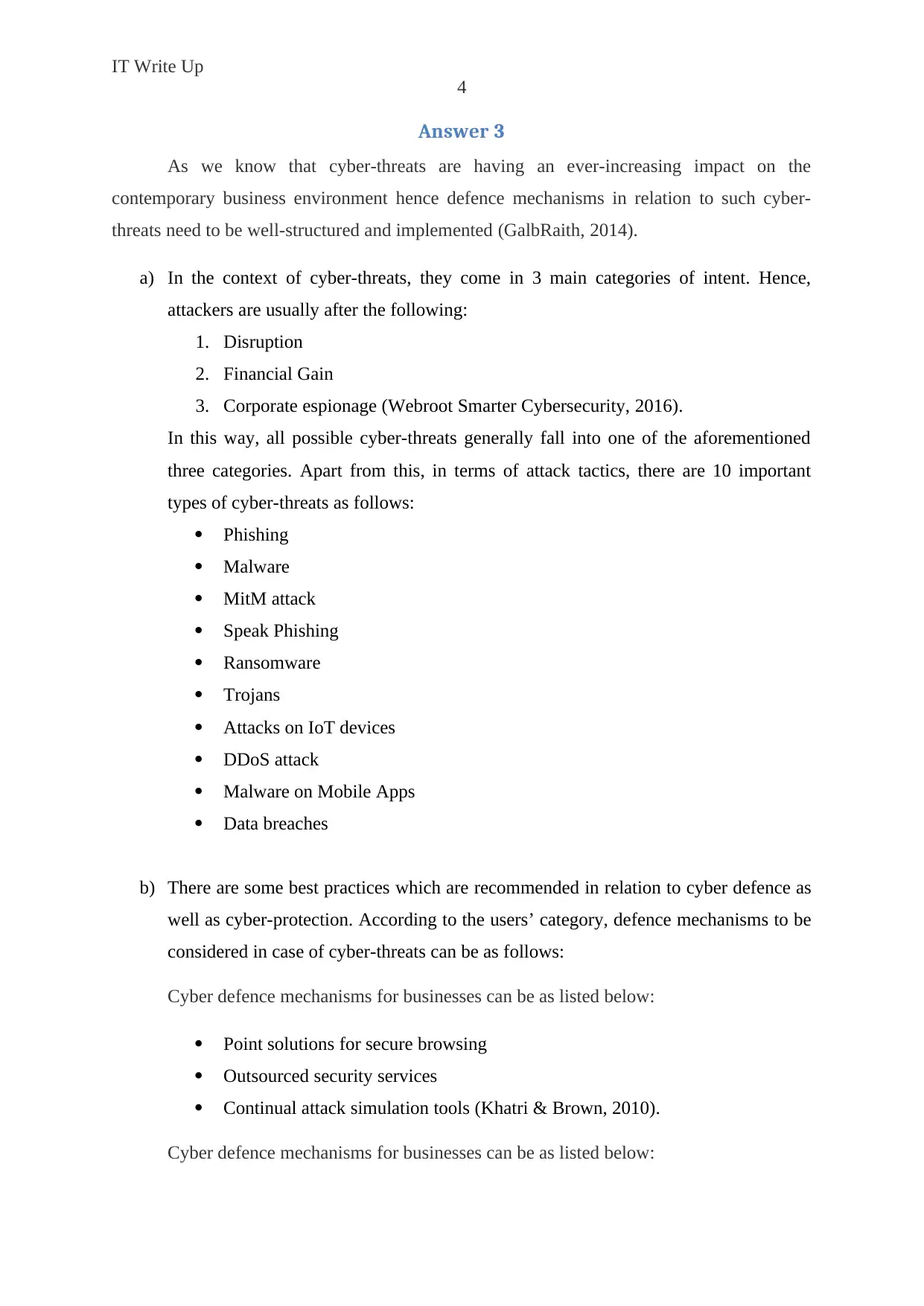
IT Write Up
4
Answer 3
As we know that cyber-threats are having an ever-increasing impact on the
contemporary business environment hence defence mechanisms in relation to such cyber-
threats need to be well-structured and implemented (GalbRaith, 2014).
a) In the context of cyber-threats, they come in 3 main categories of intent. Hence,
attackers are usually after the following:
1. Disruption
2. Financial Gain
3. Corporate espionage (Webroot Smarter Cybersecurity, 2016).
In this way, all possible cyber-threats generally fall into one of the aforementioned
three categories. Apart from this, in terms of attack tactics, there are 10 important
types of cyber-threats as follows:
Phishing
Malware
MitM attack
Speak Phishing
Ransomware
Trojans
Attacks on IoT devices
DDoS attack
Malware on Mobile Apps
Data breaches
b) There are some best practices which are recommended in relation to cyber defence as
well as cyber-protection. According to the users’ category, defence mechanisms to be
considered in case of cyber-threats can be as follows:
Cyber defence mechanisms for businesses can be as listed below:
Point solutions for secure browsing
Outsourced security services
Continual attack simulation tools (Khatri & Brown, 2010).
Cyber defence mechanisms for businesses can be as listed below:
4
Answer 3
As we know that cyber-threats are having an ever-increasing impact on the
contemporary business environment hence defence mechanisms in relation to such cyber-
threats need to be well-structured and implemented (GalbRaith, 2014).
a) In the context of cyber-threats, they come in 3 main categories of intent. Hence,
attackers are usually after the following:
1. Disruption
2. Financial Gain
3. Corporate espionage (Webroot Smarter Cybersecurity, 2016).
In this way, all possible cyber-threats generally fall into one of the aforementioned
three categories. Apart from this, in terms of attack tactics, there are 10 important
types of cyber-threats as follows:
Phishing
Malware
MitM attack
Speak Phishing
Ransomware
Trojans
Attacks on IoT devices
DDoS attack
Malware on Mobile Apps
Data breaches
b) There are some best practices which are recommended in relation to cyber defence as
well as cyber-protection. According to the users’ category, defence mechanisms to be
considered in case of cyber-threats can be as follows:
Cyber defence mechanisms for businesses can be as listed below:
Point solutions for secure browsing
Outsourced security services
Continual attack simulation tools (Khatri & Brown, 2010).
Cyber defence mechanisms for businesses can be as listed below:

IT Write Up
5
In the case of individuals, there are some best practices which are generally
considered as the cyber defence mechanisms as follows:
Anti-virus software: subscribing anti-virus software will keep an individual’s
system updated with scheduled and automated scans
Password hygiene
Caution against phishing attacks
c) There are so many significant reasons why APT threats are specifically difficult to
address, as follows:
Widespread backdoor Trojans
Unpredicted information flows
Unpredicted data bundles
Concentrated spear-phishing campaigns
Hike in elevated log-ons late at night (Data resolve, 2018).
d) There are some significant ways into which it can be explained how Defence-In-
Depth Model can assist to address the Cyber-Threats, as follows:
By offering Website protection: the protection scheme involves a combination
of security offerings along with the training for blocking threats and protecting
critical data (Berson, Dubov, Plagman, & Raskas, 2011).
By providing Network Security: when a firm sets up a firewall as a network
security means, and then it encrypts data flowing throughout the network. In
this way, when attackers get past the firewall to steal data, the data will be
encrypted because of Defence-in-depth information assurance.
References
Berson, A., Dubov, L., Plagman, B., & Raskas, P. (2011). Master data management and data
governance. UK: McGraw Hill.
Data resolve. (2018). Intellectual Property Theft Solutions. Retrieved 10 13, 2018, from
https://www.dataresolve.com/intellectual-property-theft.php
GalbRaith, J. (2014). Organizational design challenges resulting from big data. Journal of
Organization Design, 3(1), 2-13.
5
In the case of individuals, there are some best practices which are generally
considered as the cyber defence mechanisms as follows:
Anti-virus software: subscribing anti-virus software will keep an individual’s
system updated with scheduled and automated scans
Password hygiene
Caution against phishing attacks
c) There are so many significant reasons why APT threats are specifically difficult to
address, as follows:
Widespread backdoor Trojans
Unpredicted information flows
Unpredicted data bundles
Concentrated spear-phishing campaigns
Hike in elevated log-ons late at night (Data resolve, 2018).
d) There are some significant ways into which it can be explained how Defence-In-
Depth Model can assist to address the Cyber-Threats, as follows:
By offering Website protection: the protection scheme involves a combination
of security offerings along with the training for blocking threats and protecting
critical data (Berson, Dubov, Plagman, & Raskas, 2011).
By providing Network Security: when a firm sets up a firewall as a network
security means, and then it encrypts data flowing throughout the network. In
this way, when attackers get past the firewall to steal data, the data will be
encrypted because of Defence-in-depth information assurance.
References
Berson, A., Dubov, L., Plagman, B., & Raskas, P. (2011). Master data management and data
governance. UK: McGraw Hill.
Data resolve. (2018). Intellectual Property Theft Solutions. Retrieved 10 13, 2018, from
https://www.dataresolve.com/intellectual-property-theft.php
GalbRaith, J. (2014). Organizational design challenges resulting from big data. Journal of
Organization Design, 3(1), 2-13.
⊘ This is a preview!⊘
Do you want full access?
Subscribe today to unlock all pages.

Trusted by 1+ million students worldwide
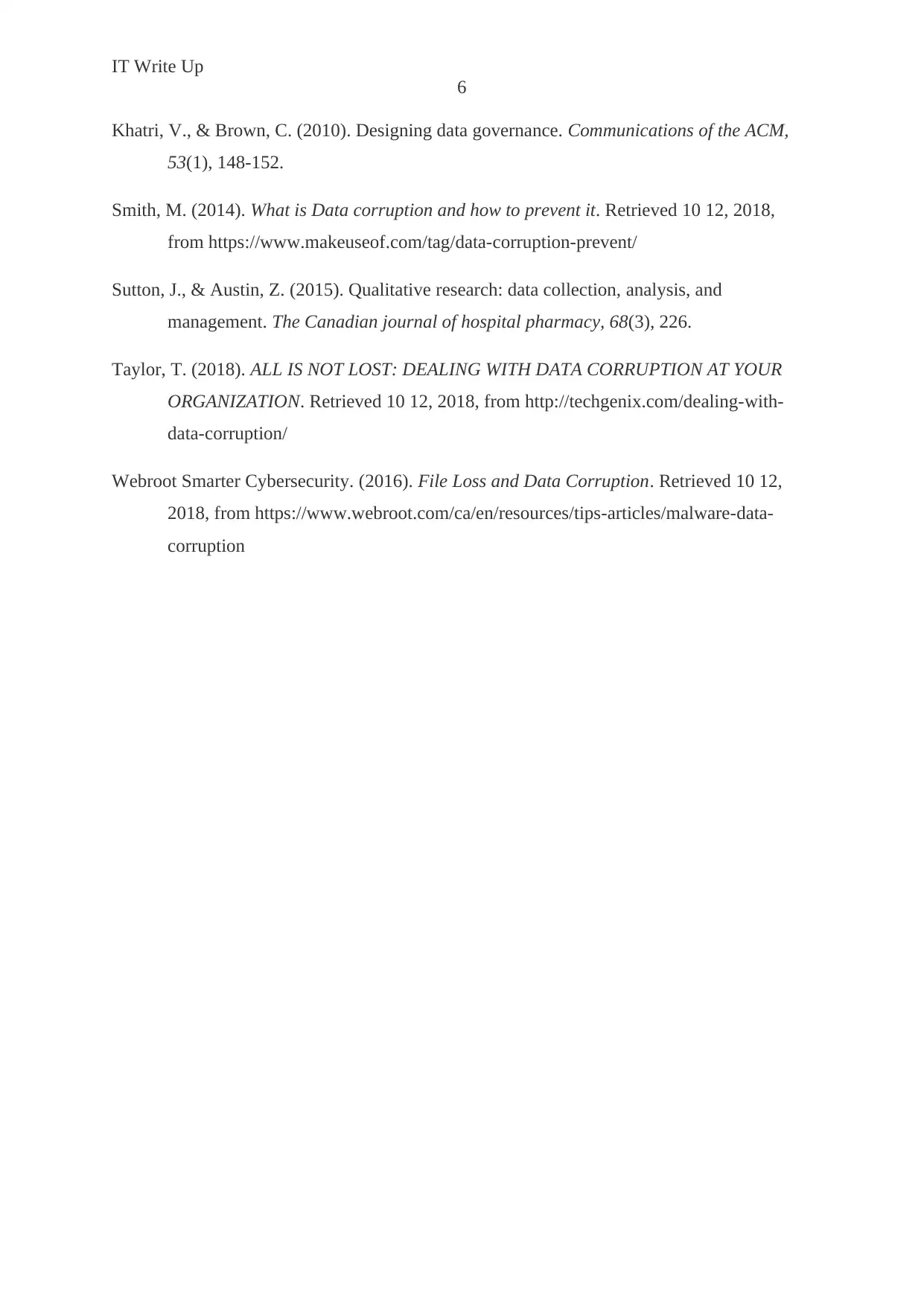
IT Write Up
6
Khatri, V., & Brown, C. (2010). Designing data governance. Communications of the ACM,
53(1), 148-152.
Smith, M. (2014). What is Data corruption and how to prevent it. Retrieved 10 12, 2018,
from https://www.makeuseof.com/tag/data-corruption-prevent/
Sutton, J., & Austin, Z. (2015). Qualitative research: data collection, analysis, and
management. The Canadian journal of hospital pharmacy, 68(3), 226.
Taylor, T. (2018). ALL IS NOT LOST: DEALING WITH DATA CORRUPTION AT YOUR
ORGANIZATION. Retrieved 10 12, 2018, from http://techgenix.com/dealing-with-
data-corruption/
Webroot Smarter Cybersecurity. (2016). File Loss and Data Corruption. Retrieved 10 12,
2018, from https://www.webroot.com/ca/en/resources/tips-articles/malware-data-
corruption
6
Khatri, V., & Brown, C. (2010). Designing data governance. Communications of the ACM,
53(1), 148-152.
Smith, M. (2014). What is Data corruption and how to prevent it. Retrieved 10 12, 2018,
from https://www.makeuseof.com/tag/data-corruption-prevent/
Sutton, J., & Austin, Z. (2015). Qualitative research: data collection, analysis, and
management. The Canadian journal of hospital pharmacy, 68(3), 226.
Taylor, T. (2018). ALL IS NOT LOST: DEALING WITH DATA CORRUPTION AT YOUR
ORGANIZATION. Retrieved 10 12, 2018, from http://techgenix.com/dealing-with-
data-corruption/
Webroot Smarter Cybersecurity. (2016). File Loss and Data Corruption. Retrieved 10 12,
2018, from https://www.webroot.com/ca/en/resources/tips-articles/malware-data-
corruption
1 out of 7
Related Documents
Your All-in-One AI-Powered Toolkit for Academic Success.
+13062052269
info@desklib.com
Available 24*7 on WhatsApp / Email
![[object Object]](/_next/static/media/star-bottom.7253800d.svg)
Unlock your academic potential
Copyright © 2020–2025 A2Z Services. All Rights Reserved. Developed and managed by ZUCOL.





